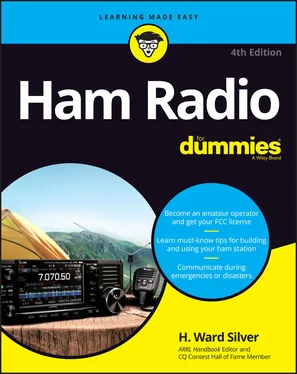1 ...7 8 9 11 12 13 ...25  Many radios have an interface that allows a computer to control the radio directly. If your computer doesn’t have a COM port (most new computers do not), you can use USB adapters that appear as a serial or COM port to your computer. Some radios are available with Ethernet ports so that they can be connected to a router or home network and operated by remote control (discussed in Chapter 12).
Many radios have an interface that allows a computer to control the radio directly. If your computer doesn’t have a COM port (most new computers do not), you can use USB adapters that appear as a serial or COM port to your computer. Some radios are available with Ethernet ports so that they can be connected to a router or home network and operated by remote control (discussed in Chapter 12).
Communication Technologies
 Whatever the type of equipment in your station, the exam will cover the following technologies that are used in ham radio:
Whatever the type of equipment in your station, the exam will cover the following technologies that are used in ham radio:
Modulation/demodulation: Modulation is the process of adding information to a radio signal so that the information can be transmitted over the air. Demodulation is the process of recovering information from a received signal. Ham radios primarily use two kinds of modulation: amplitude modulation (AM) and frequency modulation (FM), similar to what you receive on your car radio or home stereo.
Modes: A mode is a specific combination of modulation and information. You can choose among several modes when transmitting, including voice, data, video, and Morse code.
Repeaters: Repeaters are relay stations that listen on one frequency and retransmit what they hear on a different frequency. Because repeaters are often located on tall buildings, towers, or hilltops, they enable hams to use low-power radios to converse over a wide region. They can be linked by radio or the Internet to extend communication around the world. Repeaters can listen and transmit at the same time — a feature called duplex operation.
Satellites: Just like the military and commercial services, hams construct and use their own satellites. (We piggyback on commercial satellite launches; we don’t build our own rockets!) Some amateur satellites act like repeaters in the sky; others make scientific measurements, and some relay digital messages and data.
Software-Defined Radio (SDR): Microprocessors perform many of the radio’s functions, generating and receiving signals by processing them as digital data. Some radios consist almost completely of software running on a PC. SDR technology is extremely flexible and enables hams a wide variety of operating choices and features.
Networks: Hams have constructed radio-linked computer networks and a worldwide system of email servers accessed by radio. Some of the most popular voice modes consist of digitized speech routed between repeater stations over the Internet.
HAM RADIOS, CB RADIOS, AND MOBILE PHONES
Radios abound — enough to boggle your mind. Here are the differences between your ham radio and other radio services:
Citizens Band (CB): CB radio uses 40 channels near the 28 MHz ham band. CB radios are low-power and useful for local communications only, although the radio waves sometimes travel long distances. You don’t need a license to operate a CB radio. This lightly regulated service is plagued by illegal operation, which diminishes its usefulness.
Family Radio Service (FRS) and General Mobile Radio Service (GMRS): These popular radios, such as the Motorola Talkabout models, are designed for short-range communications between family members. Both operate with low power on UHF frequencies. FRS operation is unlicensed, but using the GMRS channels (see the radio’s operating manual or guide) does require a license.
Broadcasting: Although hams are often said to be broadcasting, that is incorrect. Hams are barred from doing any one-way broadcasting of programs the way that AM, FM, and TV stations do. Broadcasting without the appropriate license attracts a lot of attention from a certain government agency whose initials are FCC.
Public-safety and commercial mobile radio: The handheld and mobile radios used by police officers, firefighters, construction workers, and delivery-company couriers are similar in many ways to VHF and UHF ham radios. In fact, the bands are so close in frequency that hams often convert and use surplus equipment. Commercial and public-safety radios require a license to operate.
Mobile or cell phones: Obviously, you don’t need a license to use a mobile phone, but you can communicate only through a licensed service provider on one of the mobile phone allocations from 700 MHz through 2 GHz. (The new 5G services go much higher in frequency.) Although the phones are actually small UHF and microwave radios, they generally don’t communicate with other phones directly and are completely dependent on the mobile phone network to operate.
WiFi: Your wireless network router, gateway, or access point is really a radio transceiver operating on the 2.4- or 5.6-GHz bands. That’s what those little moveable antennas are for! Your phone or tablet has small antennas and a WiFi transceiver inside, too.
 Hams have always been interested in pushing the envelope when it comes to applying and developing radio technology — one of the fundamental reasons why ham radio exists as a licensed service. Today, ham inventions include such things as creating novel hybrids of radio and other technologies, such as the Internet or GPS radio location. Ham Mesh networks, for example, consists of wireless local area network technology adapted to ham radio. Ham radio is also a hotbed of innovation in antenna design and construction — in short, techie heaven!
Hams have always been interested in pushing the envelope when it comes to applying and developing radio technology — one of the fundamental reasons why ham radio exists as a licensed service. Today, ham inventions include such things as creating novel hybrids of radio and other technologies, such as the Internet or GPS radio location. Ham Mesh networks, for example, consists of wireless local area network technology adapted to ham radio. Ham radio is also a hotbed of innovation in antenna design and construction — in short, techie heaven!
Understanding the Fundamentals of Radio Waves
Getting the most out of ham radio (or any type of radio) is greatly improved by having a general understanding of the purpose of radio: to send and receive information by using radio waves.
Radio waves are another form of light that travels at the same speed: 186,000 miles per second. Radio waves can get to the Moon and back in 2½ seconds or circle the Earth in  second.
second.
 For the exam, you’ll need to know that the energy in a radio wave is electromagnetic . That is, the waves are made up of both electric and magnetic fields . (A field is just a way of storing energy in space, like a gravitational field that makes you experience weight.) The radio wave’s field makes charged particles — such as the electrons in a wire — move in sync with the radio wave. These moving electrons are a current, just like in an AC power cord except that they form a radio frequency current that your receiver turns into, say, audible speech.
For the exam, you’ll need to know that the energy in a radio wave is electromagnetic . That is, the waves are made up of both electric and magnetic fields . (A field is just a way of storing energy in space, like a gravitational field that makes you experience weight.) The radio wave’s field makes charged particles — such as the electrons in a wire — move in sync with the radio wave. These moving electrons are a current, just like in an AC power cord except that they form a radio frequency current that your receiver turns into, say, audible speech.
This process works in reverse to create radio waves. Transmitters cause electrons to move so that they, in turn, create the radio waves. Antennas are just structures in which the electrons move to create and launch radio waves into space. The electrons in an antenna also move in response to radio waves from other antennas. In this way, energy is transferred from moving electrons at one station to radio waves and back to moving electrons at the other station.
 You will see radio waves referred to as electromagnetic radiation . Don’t let the word radiation alarm you (or your neighbors). This is just a general term for any kind of electromagnetic energy flying around. There isn’t nearly enough energy in a radio wave to cause the same kind of concern as nuclear or ionizing radiation. It’s not even close! Radio waves are non-ionizing radiation and can’t cause the genetic effects or other damage associated with radioactivity.
You will see radio waves referred to as electromagnetic radiation . Don’t let the word radiation alarm you (or your neighbors). This is just a general term for any kind of electromagnetic energy flying around. There isn’t nearly enough energy in a radio wave to cause the same kind of concern as nuclear or ionizing radiation. It’s not even close! Radio waves are non-ionizing radiation and can’t cause the genetic effects or other damage associated with radioactivity.
Читать дальше

 Many radios have an interface that allows a computer to control the radio directly. If your computer doesn’t have a COM port (most new computers do not), you can use USB adapters that appear as a serial or COM port to your computer. Some radios are available with Ethernet ports so that they can be connected to a router or home network and operated by remote control (discussed in Chapter 12).
Many radios have an interface that allows a computer to control the radio directly. If your computer doesn’t have a COM port (most new computers do not), you can use USB adapters that appear as a serial or COM port to your computer. Some radios are available with Ethernet ports so that they can be connected to a router or home network and operated by remote control (discussed in Chapter 12). Whatever the type of equipment in your station, the exam will cover the following technologies that are used in ham radio:
Whatever the type of equipment in your station, the exam will cover the following technologies that are used in ham radio: second.
second.










